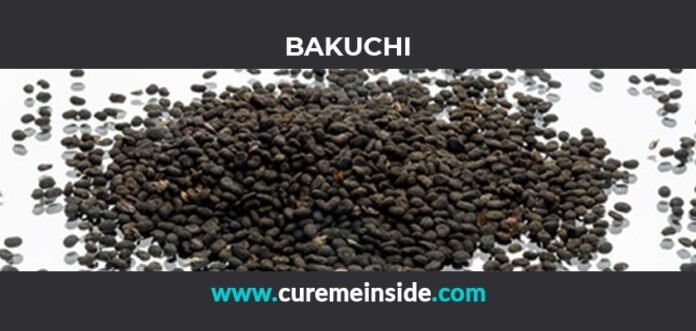Bakuchi (Psoralea corylifolia)
Bakuchi sBakuchi Bakuchi is a valuable herb with medicinal properties.(HR/1)
Bakuchi seeds are kidney-shaped and have a bitter taste and an awful odour. Bakuchi oil is a skin-healing home medicine. The anti-inflammatory properties of Bakuchi oil blended with coconut oil assist to minimise inflammatory reactions on the skin. Due to its great healing properties, it also aids in the reduction of boils and skin outbreaks. Bakuchi powder’s Keshya virtue, according to Ayurveda, aids hair development and prevents dandruff when applied externally. Bakuchi’s Kusthagna and Rasayana characteristics, according to Ayurveda, assist treat Vitiligo spots by decreasing white areas.Bakuchi powder, when combined with honey, inhibits pigment-forming cells from being destroyed due to its immunomodulatory properties. Because of its antiviral properties, it can also be utilised to treat respiratory disorders. Bakuchi’s antioxidant properties also aid in the management of liver injury by avoiding further hepatic cell damage. Bakuchi should be taken in tiny dosages, according to Ayurveda, because large doses might cause hyperacidity and gastritis. Bakuchi’s Kusthagna and Rasayana characteristics, according to Ayurveda, assist treat Vitiligo spots by decreasing white areas.
Bakuchi is also known as :- Psoralea corylifolia, Babchi, Babacha, Babichi, Habchu, Karkokil, Kaurkolari
Bakuchi is obtained from :- Plant
Uses and benefits of Bakuchi:-
As per several scientific studies, uses and benefits of Bakuchi (Psoralea corylifolia) are mentioned as per below(HR/2)
- Vitiligo : Due to its Kusthaghna and Rasayana characteristics, Bakuchi treats vitiligo spots by reducing the white patches. The darker area gradually covers all white skin area, resulting in obvious skin changes.
- Skin disease : Bakuchi’s Raktashodaka (Blood Purifier) characteristics serve to treat a variety of skin problems such as irritating red papules, itching eruptions, eczema, ringworm, rough and discoloured dermatosis, and dermatosis with fissures.
- Indigestion : Bakuchi aids digestion by promoting digestive fire and allowing food to be digested more quickly due to its Ushna (hot) potency.
- Worm infestation : Bakuchi’s Krimighna (anti-worm) property helps to treat worm infestations.
- Cough disordes : Bakuchi can help reduce asthma, cough, and bronchitis because it can balance Kapha and possesses Ushna Virya (hot in potency).
- Vitiligo : Bakuchi helps to control vitiligo since it shrinks the white spots, causing the darker area to gradually cover all white skin, resulting in apparent skin changes due to its Kusthaghna function. Because of its Ropan (healing) nature, it also aids in rapid healing when administered externally to the damaged area.
- Hair Loss : The Keshya (hair growth enhancer) feature of Bakuchi powder stimulates hair development and reduces dandruff when applied externally.
- Wound : Because of its Ropan (healing) characteristics, Bakuchi aids in the speedy healing of wounds when applied to the damaged area. Bakuchi was able to speed up the healing of wounds due to its characteristic.
Video Tutorial
Precautions to be taken while using Bakuchi:-
As per several scientific studies, below precautions should to be taken while taking Bakuchi (Psoralea corylifolia)(HR/3)
- Bakuchi should be taken in recommended dose and duration since high dose and prolonged usage can cause hyperacidity and gastritis.
- Some products like curd, pickles, fish etc. should be avoided in case of vitiligo treatment with Bakuchi churna beacause these are Apathya with treatment.
- Bakuchi seed paste should be used with milk, rose water or any cooling substance if your skin is hypersensitive since it is Ushna Virya (hot in potency).
- Bakuchi oil also can cause mild skin irritation and burning sensation when applied externally. So use it with coconut oil or with your moisturizing lotion.
Special precautions to be taken while taking Bakuchi:-
As per several scientific studies, below special precautions should to be taken while taking Bakuchi (Psoralea corylifolia)(HR/4)
- Breastfeeding : Bakuchi should only be used when breast-feeding under medical supervision.
- Pregnancy : During pregnancy, Bakuchi should only be used under medical supervision.
How to take Bakuchi:-
As per several scientific studies, Bakuchi (Psoralea corylifolia) can be taken into the methods mentioned as per below(HR/5)
- Bakuchi Churna With honey : Take one fourth to half teaspoon Bakuchi Churna. Add one teaspoon honey. Have it after lunch and supper.
- Bakuchi Capsule : Take one to two Bakuchi Capsule swallow it with water after lunch and also supper.
- Bakuchi Tablet : Take one to two Bakuchi Tablet ingest it with water after lunch and supper.
How much Bakuchi should be taken:-
As per several scientific studies, Bakuchi (Psoralea corylifolia) should be taken into the amounts mentioned as per below(HR/6)
- Bakuchi Churna : One fourth to half twice a day.
- Bakuchi Capsule : One to two capsules twice a day.
- Bakuchi Tablet : One to two tablets twice a day.
- Bakuchi Oil : Two to five drops or as per your requirement.
- Bakuchi Powder : Half to one teaspoon or as per your requirement.
Side effects of Bakuchi:-
As per several scientific studies, below side effects need to be taken into consideration while taking Bakuchi (Psoralea corylifolia)(HR/7)
- There is not enough scientific data available about side effects of this herb yet.
Questions asked frequently Related to the Bakuchi:-
Question. How to apply Bakuchi (Babchi) seed oil on the face and body?
Answer. The following procedure can be used to apply bakuchi seed oil on the face and body in conjunction with coconut oil: 1. Add a few drops of Bakuchi oil on your palms (as per your requirement). 2. Mix with an equal amount of coconut oil. 3. Apply it 4-5 times a day to the afflicted area.
Question. How should Bakuchi be used for the treatment of vitiligo or Leucoderma?
Answer. Bakuchi oil should be applied to the skin topically and gently rubbed in. The oil increases skin pigmentation, which aids in the treatment of vitiligo. It contains immunomodulatory properties, which means it raises the number of melanocytes in the body (pigment-forming cells). It also aids in the removal of toxins from the skin as well as revitalising the area.
The imbalance of Pitta in the body causes vitiligo. Pitta imbalance causes the production of Ama (toxin that lingers in the body owing to indigestion), impairing deeper body tissues. Depigmentation of the skin results as a result of this. Bakuchi’s Deepan (appetiser), Pachan (digestion), and Ropan (digestion) qualities aid in the management of this ailment. It improves the digestive system, which aids in the digestion of Ama, as well as healing the illness, bringing comfort. Its Rasayana (rejuvenating) function also aids in skin rejuvenation. Tips 1. Take as much Bakuchi oil as you need. 2. Combine it with the same amount of coconut oil. 3. Apply this combination to the affected area and expose it to sunshine in the morning. 4. Do this every day for best effects.
Question. Can Bakuchi be used for respiratory diseases?
Answer. There isn’t enough scientific data to back up Bakuchi’s role in respiratory disorders.
Yes, Bakuchi can be used to treat respiratory disorders like cough, which are caused by a Kapha dosha imbalance. Mucus forms and accumulates in the respiratory tract as a result of this. Due to its Kapha balancing and Rasayana (rejuvenation) characteristics, Bakuchi helps to control this condition. It aids in the maintenance of your general health by reducing the development of mucus.
Question. What are the uses of Bakuchi in diarrhea?
Answer. There isn’t enough scientific data to back up Bakuchi’s function in diarrhoea.
Question. Is Bakuchi helpful in jaundice?
Answer. Although there is insufficient scientific evidence to suggest Bakuchi’s role in jaundice. Bakuchi, on the other hand, may protect the liver from harm due to its antioxidant properties. It combats free radicals and may protect liver cells from harm.
Yes, Bakuchi may aid with jaundice, which is caused by an imbalance of the three doshas, resulting in sluggish digestion and a loss of appetite. Due to its Rasayana (rejuvenation) and Deepan (appetiser) characteristics, Bakuchi helps to control this disease. It aids your digestion and increases your appetite while also maintaining your overall health.
Question. What are the side effects of Bakuchi Churna?
Answer. Bakuchi churna usually has no negative side effects. However, before using Bakuchi churna, you should always visit your doctor.
Question. What are the medicinal uses of Bakuchi oil?
Answer. Bakuchi oil is beneficial in infections because of its antifungal and antibacterial qualities, which prevent the growth of fungi and bacteria. Its anti-inflammatory qualities also help to avoid skin irritation. As a result, it aids in the treatment of vitiligo, boils, and skin eruptions.
Because of its Ropan (healing) quality, Bakuchi oil can be used for local application in situations like vitiligo. For best results, use it with coconut oil. It aids in the healing of the patches that develop as a result of this illness. Tips 1. Apply a few drops of Bakuchi oil to your palms. 2. Pour in the same amount of coconut oil. 3. Use it to treat the damaged region.
SUMMARY
Bakuchi seeds are kidney-shaped and have a bitter taste and an awful odour. Bakuchi oil is a skin-healing home medicine.




